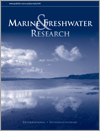Marine and Freshwater Research
Volume 72
Number 9 2021
Behavioural observations of the eastern Australian population of humpback whales were used to identify critical habitat of this population. Study outcomes revealed Gold Coast Bay and Hervey Bay in Queensland as essential resting and socialising grounds, but with distinct differences. This shows that the two regions are critical habitats for humpback whales during their annual migration, but for different essential activities, such as courtship and resting.
The age of whole barramundi (Lates calcarifer) otoliths from the southern Gulf of Carpentaria were estimated using Fourier transform near-infrared (FT-NIR) spectroscopy. Results suggest that when seasonal variability is incorporated into the calibration model, FT-NIR has the ability to predict over 96% of samples within 1 year of the reference age.
The eastern shovelnose ray is a coastal batoid endemic to the eastern coast of Australia, commonly caught as by-catch in Queensland’s prawn trawl fishery. Growth and age-at-maturity for A. rostrata were assessed and this species exhibits slow growth and late maturity, which are common life-history strategies among elasmobranchs. Females attain a larger size and mature later than do males.
Stream-bank damage by horses is a risk to the ecology of streams. Our study showed that interactions with streams by horses led to turbidity in streams that peaked at 50 times the national guideline value, and, in summer, averaged eight times greater than the guideline values. This poses a clear risk to biodiversity and ecological processes in those streams. Linear relationships between turbidity and riparian damage suggest that any level of horse presence affects subalpine waterways.
Seagrass wasting disease is a very devastating infection that darkens the blades and threatens several marine ecosystems that rely on seagrass meadows. We investigated the dynamics of leaf-associated bacteria in healthy and diseased individuals of the seagrass species Zostera muelleri and found that pronounced changes take place within these communities, even in the absence of the proposed aetiological agent Labyrinthula zosterae.
Climate change is warming the world’s oceans, and will disrupt marine populations. We have shown that in Alaska and Washington nearshore waters, the recruitment and abundance of giant Pacific octopuses fell sharply following years of higher average ocean temperatures. Visual surveys and ocean temperature data together may allow better management of octopus harvests.
Prochilodus lineatus is a migratory Neotropical fish that constitutes the principal targeted species in the fishery of the Lower Rio de la Plata Basin. P. lineatus larvae drift downstream from spawning to nursery areas, where first feeding takes place. This study experimentally investigated the morphological, physiological and behavioural changes in P. lineatus larvae under food-deprivation v. feeding conditions. The results are discussed in the context of the distribution and survival of wild larvae.
Algal diversity and their conservation value remain largely understudied, despite that environmental pressures in the rivers of arid and semiarid regions of Patagonia are a major concern. This study shows that diatoms are more diverse than was previously recognised in the Chubut River, where a high proportion of endemic elements could occur. Ecological preferences of some diatom species also suggest an enrichment of nutrients towards the lower basin and show the maximum intrusion of seawater into the estuary.
We investigated spring diatom blooms in a temperate freshwater river that is thought to predominantly include the diatom Stephanodiscus hantzschii. The results suggested the coexistence of many diatoms during spring blooms. However, Cyclotella sp. was responsible for the spring bloom attributed to S. hantzschii. The co-occurrence of similar species should be considered when implementing efforts to control spring blooms.
A novel approach, the CDOMLH algorithm, was developed to retrieve the absorption coefficient of chromophoric dissolved organic matter (aCDOM) in non-turbid waters, and was calibrated and validated. One implication for the MERIS satellite data, which exhibit reasonable seasonal variability over the East China Sea, is that it can be used to explore biogeochemical effects on aquatic environments.
A model to refine release densities for crustaceans targeted for stocking into estuaries or freshwaters is presented. The approach uses bioenergetic information, which can be measured readily in the laboratory, alongside estimates of primary productivity, growth and mortality, to optimise stocking density for species and ecosystems on the basis of expected trophic impact of the stocked cohorts. The model is generalised so that simulations can be made for any species or system for which parameters can be estimated or measured.
Owing to species diversity, uncertainties regarding the relationships among the different groups of Percomorpha have always been a challenge in conducting phylogenetic studies on teleosts. In this study, the genomes of 34 representative species of the 7 major taxa of Percomorpha were evaluated to solve this problem. The present study provides a new perspective and possibilities for further studies on the Percomorpha branch and other higher-order meta-taxonomic relationships of fish.





